Ballycarty House
Houses within 5km of this house
Displaying 19 houses.
Houses within 5km of Ballycarty House
Displaying 19 houses.
| House name | Description | |
|---|---|---|
| Caherwisheen | Robert A. Thompson was in possession of this property at the time of Griffith's Valuation, when it was valued at £15. | |
| Cloghane Lodge or Fortlands | At the time of Griffith's Valuation, it was being leased by Francis Fitzgerald to Andrew Shea and was valued at £15. It is still extant. Bary writes that this house was built by the Conway family, possibly in the seventeenth century. It was eventually sold by Nicholas Conway Colthurst to Peter Thompson in the 1820s. The 1856 sale notice records Francis Fitzgerald as the assignee of Peter Thompson. | |
| Cloghers House | In 1786 Wilson refers to Cloghers as the seat of Richard Yielding. John Mulchinock was leasing two adjoining properties from the Colthurst estate at the time of Griffith's Valuation, one valued at £50 and the second at £15. The Irish Tourist Association Survey notes that Cloghers was "once the home of the Mulchinock family who were big landowners" and relates the story of the song "the Rose of Tralee". Bary writes that this property was associated with the Carrigue family in the eighteenth century and also that John Mulchinock was an uncle of William Mulchinock, author of the song. She indicates that it was later owned by the Fitzmaurice family. It is still extant. |
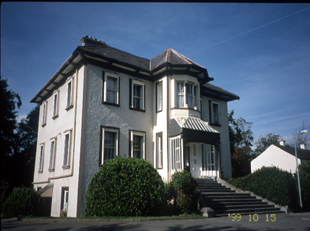
|
| Belmont | Reverend Arthur Rowan was leasing Belmont from Arthur Chute at the time of Griffith's Valuation, when it was valued at £40. Lewis records it as the seat of Reverend A.B. Rowan in 1837. The Ordnance Survey Name Books suggest the house was built by his father in 1826 and cost £1500. However, Bary states that the house, in common with other houses in the vicinity, was built by Peter Thompson in the 1820s, when he was Treasurer of County Kerry. It is still extant and occupied. |
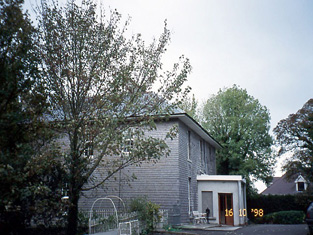
|
| Chute Hall | Richard Chute was occupying Chute Hall at the time of Griffith's Valuation, when it was valued at £37 10s. Lewis also records it as his residence in 1837. The house is named "Tullygarran House" on the 1st edition of the Ordnance Survey map and is so described in the Ordnance Survey Name Books where it is noted it was "three stories high and about a century old". The house later became known as Chute Hall. Bary notes that the Chutes had been resident in this area since the seventeenth century on what had been McElligott land. In 1894 it was the residence of Mrs. Chute. Richard, the last of the Chutes to live here, died in 1936. In 1943 the Irish Tourist Association Survey noted Chute Hall "now almost a wreck but once a fine imposing structure." The house has been demolished but the substantial gateway remains inside which are some fine ogham stones. |

|
| Arabela House | Rev. Arthur Rowan was leasing this property to Hastings Peate at the time of Griffith's Valuation, when it was valued at £20 15s. Lewis records it as the seat of Francis Peet in 1837. The Ordnance Survey Name Books mention that it was the residence of Francis Peet, "of old appearance, built about a century ago". In 1814 Leet notes it as the seat of John Bolton. In 1786 Wilson refers to Arabella as a seat of Mr. Blennerhassett. Bary states that the house was built in the eighteenth century by the Blennerhassetts but that it was lived in by the Rowan family until the mid-nineteenth century. The Peate family occupied it from then until the 1970s. It is still extant. |
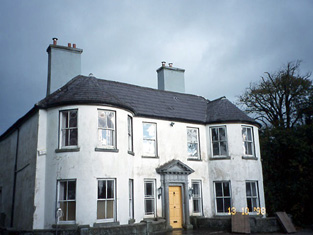
|
| Rathanny House | Elizabeth Rowan was leasing a property to Patrick Holohan at the time of Griffith's Valuation, when it was valued at almost £3. Lewis refers to Rathanny as the residence of Mrs. Rowan in 1837. In the 1830s the Ordnance Survey Name Books noted the house, built c.1730, as the residence of Mrs. Rowan In 1786 Wilson mentions Ratanny as the seat of Mr. Rowan. Bary states that the house was built by the Rowan family in the eighteenth century and lived in by them for much of the early nineteenth century. It was sold in the early twentieth century and is still extant and occupied. |
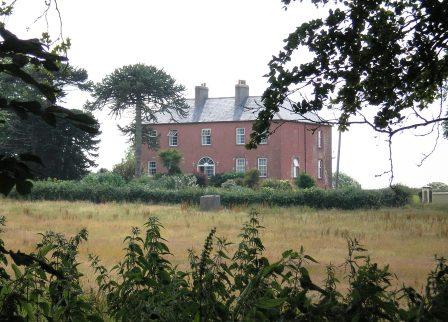
|
| Spring Hill | Richard Chute was leasing Spring Hill to Penelope Chute at the time of Griffith's Valuation, when it was valued at £23. Bary notes that Richard Chute enlarged and extended an existing house here in 1816. Lewis records the house as the seat of Captain Chute in 1837. The Ordnance Survey Name Books note that the original house was thatched but the house existing in the 1830s was "two stories high and neatly built". In the later nineteenth century, the Linden family, agents to the Chutes occupied Spring Hill and remained into the twentieth century. It is now ruined and overgrown. |
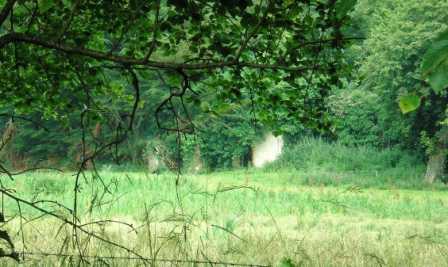
|
| Shanvally | Thomas Blennerhassett was leasing this property to Robert Conway Hurley at the time of Griffith's Valuation, when it was valued at £20. n the 1830s the Ordnance Survey Name Books describe it as the seat of Thomas Blennerhassett, who had built it in 1835. In 1786 Wilson had noted a seat of the Blennerhasset family close to the Rowan house, Ratanny. Bary states that Shanvally was built by the Blennerhassetts as a hunting lodge, possibly in the late eighteenth or early nineteenth century. It is still extant and occupied. | |
| Kilquane | Charles Blennerhassett was leasing this property to Thomas Rooney at the time of Griffith's Valuation, when it was valued at £3, on a farm of 130 acres. This may be the property to which Wilson refers as the seat of William Blennerhasset in 1786 which he names Elm-Grove. A substantial farm is extant at the site. | |
| Knockavinnane Cottage | James Hussey was leasing this property to Alexander Mason at the time of Griffith's Valuation, when it was valued at £15 15s. A portion of the original building is still extant. | |
| Magh House or Edenburn | Colthurst Bateman was leasing a property to Edward F. Day at the time of Griffith's Valuation, when it was valued at £28 15s. On the 1st edition Ordnance Survey map it is labelled as Magh House but on the 1895 edition it is called Edenburn House. Lewis records it as the seat of W. Seely in 1837.The Ordnance Survey Name Books of the 1839s noted that this was the residence of the Sealy family and had been preceded by Rockfield House, the ruins of which were still discernable. Magh is described as "handsomely built of square form, three stories high and cost £2000". Later in the nineteenth century it was occupied by Edward Fitzgerald Day and then by Samuel Murray Hussey, agent to the Kenmare and other estates. In 1906 it was owned by John Hussey and valued at £24. It was used in the later twentieth century by the Southern Health Board as a hospital/nursing home and is still extant. | |
| Ashgrove Mill | John Busteed and Arthur Rowan were the lessors of a house and mill at Tonreagh, vacant at the time of Griffith's Valuation, when the complex was valued at £25 15s. | |
| Ballyseedy Castle | Ballyseedy was a seat of the Blennerhassett family for many generations. Charles Blennerhassett was occupying it at the time of Griffith's Valuation when it was valued at £60. Lewis recorded that Sir Edward Denny was living there in 1837 but that it was a seat of the Blennerhassett family. In 1906 it was owned by Arthur Blennerhassett and valued at £65. The National Inventory of Architectural Heritage (Buildings of Ireland) report states that the house was built c.1760 but renovated and extended at least twice in the nineteenth century. The Irish Tourist Association survey in 1942 reported that the owner then was Miss Hilda Blennerhassett. It remained in the ownership of the Blennerhassett family until later in the twentieth century when it was sold and became Ballyseedy Castle Hotel. [www.ballyseedecastle.com]. |

|
| O'Brennan House | John Keane was leasing this property from Lord Ventry's estate at the time of Griffith's Valuation, when it was valued at £5 10s. Lewis records O'Brennan House as the seat of Edward Gorham in 1837. It is still extant. | |
| Parkearagh | John Keane was leasing this property from Lord Ventry's estate at the time of Griffith's Valuation, when it was valued at £6. A substantial farm is extant at the site now. | |
| Ballinorig House | At the time of Griffith's Valuation, Colthurst Bateman was leasing this property to Jonathon Walpole when it was valued at £14. The building is not labelled on the Ordnance Survey maps though a more substantial house exists at the site on the later 25-inch edition. Burke records that Colthurst Bateman resided in, and was, High Sheriff of Monmouth, in 1839. Ballinorig House is still extant. | |
| Lee Brook | Francis Raymond was leasing this property to Richard Roland Chute at the time of Griffith's Valuation when it was valued at £30. In 1906 it was owned by Rowland Chute and valued at £30. Bary states that this house was associated with the Chute family and may have been built by them in the eighteenth century. It remained in the family until the 1930s and is still extant and occupied. The 25-inch edition Ordnance Survey map indicates an additional house in the townland, labelled Lee Brook House. A much enlarged version of this building now serves as Ballygarry House Hotel [Q866134]. | |
| Ash Hill House | The Ordnance Survey Name Books record Ash Hill House, parish of Ballymacelligott, as being a ruin, c.15ft high in the 1830s. It had been built by the Blennerhassetts around 1700 and was later occupied by the Eager family. In 1786 Wilson records Ash-Hill as the seat of Thomas Blennerhasset. |

